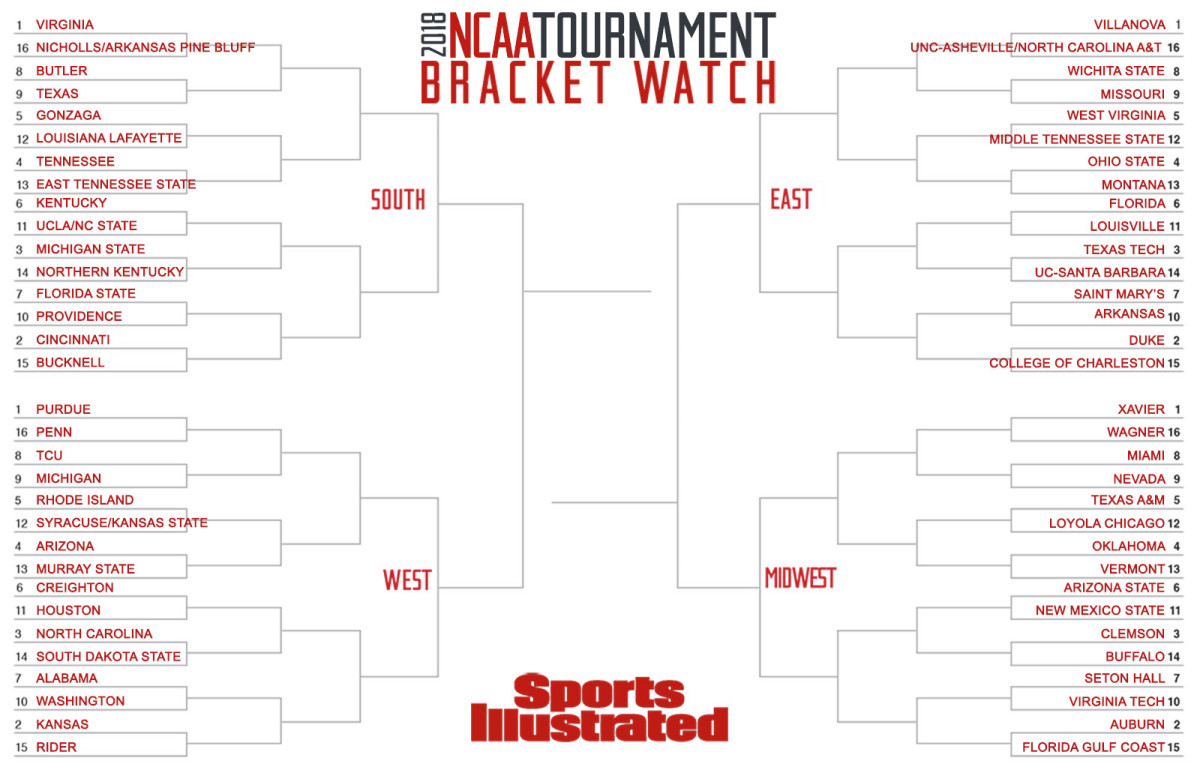Bracket Watch: Top Line Teams Hold Firm, But a Surprise Contender Lurks

The Selection Committee staged its annual early bracket release over the weekend, revealing the identities and placements of the top 16 teams in the field of 68, as it stands right now. None of those teams lost or scored major victories on Sunday, so we can safely say that they all ended the day exactly where they started it. Rather than our usual region-by-region look at the field, we’ll use this edition of the Bracket Watch to go over some of what we learned from the committee’s big reveal party and what those lessons could mean for the rest of the season.
The new quadrants matter
The Selection Committee scrapped its traditional measure of quality victories, no longer looking at win-loss record against top-50 and top-100 RPI teams. Instead, it created four quadrants based on RPI and game location. Quadrant 1 games are home games against the top-30 RPI teams, neutral floor games against the top 50 and road games against the top 75. Sunday’s bracket reveal showed that the best way to climb up the bracket is to do well in Quadrant 1 games.
The best example of this is Oklahoma, which was the most dubious selection among the top-16 teams, grabbing the No. 4 seed in the Midwest Region. Oklahoma is 16-8 overall and 6-6 in the Big 12, with an RPI of 21 and average computer ranking (average of BPI, KenPom and Sagarin rankings) of 25.33. Gonzaga, West Virginia and possibly Rhode Island could have made just as strong a case, if not a stronger one, for that final spot in the top 16. It appears that Oklahoma’s six Q1 wins set it apart, however. Gonzaga and West Virginia have five, while Rhode Island has just one. Included among Oklahoma’s six Q1 victims are Kansas and Texas Tech, which also shows an emphasis on marquee wins, no matter where they happen.
This is good news for the “who can you beat?” crowd at the backend of the field. We’ve been discussing for weeks what makes a bubble team worthy of inclusion and we keep circling back to best wins rather than volume of losses. If the emphasis on Q1 wins trickles all the way to the bottom of the at-large group, that will bode well for teams that have made their mark against their best competition, such as Temple, UCLA and Oklahoma State.
What the Selection Committee's Top 16 Reveal Means for March Madness
Cincinnati lurks as a No. 1 seed contender
The committee placed Virginia, Villanova, Xavier and Purdue on the top line. A consensus had formed around the Cavaliers, Wildcats and Boilermakers some time ago, and even though they all suffered losses this week, they deserved to remain No. 1 seeds. Xavier emerged as a possible top seed after losses by Duke and Kansas two weekends ago, and the Musketeers confirmed their No. 1-seed fitness with wins at Butler and Creighton last week.
Should any of them falter over the next month, however, Cincinnati will be ready to swoop in and move up to the top line. The Bearcats earned the fourth and final No. 2 seed, a bit of a surprise given that their four Q1 wins were over Buffalo, Temple, UCLA and UCF. Still, the committee gave the Bearcats credit for dominating the AAC and racking up a gaudy 23-2 record, No. 10 RPI and average computer ranking of 4.33.
Cincinnati may be the No. 8 overall seed, behind Auburn, Kansas and Duke on the No. 2-line, but they may have the best chance of the four to get to the top of the field, thanks to their respective conferences. The Bearcats still have two games remaining with Wichita State in the regular season, but their schedule (including the conference tournaments) is far easier than what Auburn, Kansas and Duke will deal with the rest of the way. The same goes for the current No. 1 seeds, which will have to get through more tournament-quality competition than Cincinnati to maintain their spots. If the top line looks different one month from now, the bet here is that Cincinnati will be on it.
How long are the ACC’s coattails?
The ACC may not have the volume of legitimate Final Four contenders it usually does, but the conference remains strong at the top, with four teams among the top 16 with one month to go until Selection Sunday. Virginia as the top overall seed was expected, but it wouldn’t have been a surprise to see any or all of Duke, Clemson and North Carolina seeded lower than they were. Whether that extends to the rest of the conference remains to be seen.
The committee may like the top of a conference, but that doesn’t automatically mean it will use that as a barometer for the rest of the league. Consider, for example, the Big Ten, which has three teams inside the top 16, including a No. 1 seed, but just one more likely tournament team. The ACC is clearly a better league than the Big Ten, but bubble teams can’t get by purely on the coattails of the best teams in their conference.
And yet, the strength of the ACC will have to be—at the very least—a talking point in the committee room. That could be great news for Virginia Tech—which is in position to play its way off the bubble after beating Virginia in Charlottesville over the weekend—Louisville, Syracuse and North Carolina State, which appear to be the conference’s true bubble teams.
Last Four In
UCLA
NC State
Syracuse
Kansas State
First Four Out
USC
Temple
Boise State
Mississippi State
Next Four Out
Nebraska
Oklahoma State
St. Bonaventure
LSU

